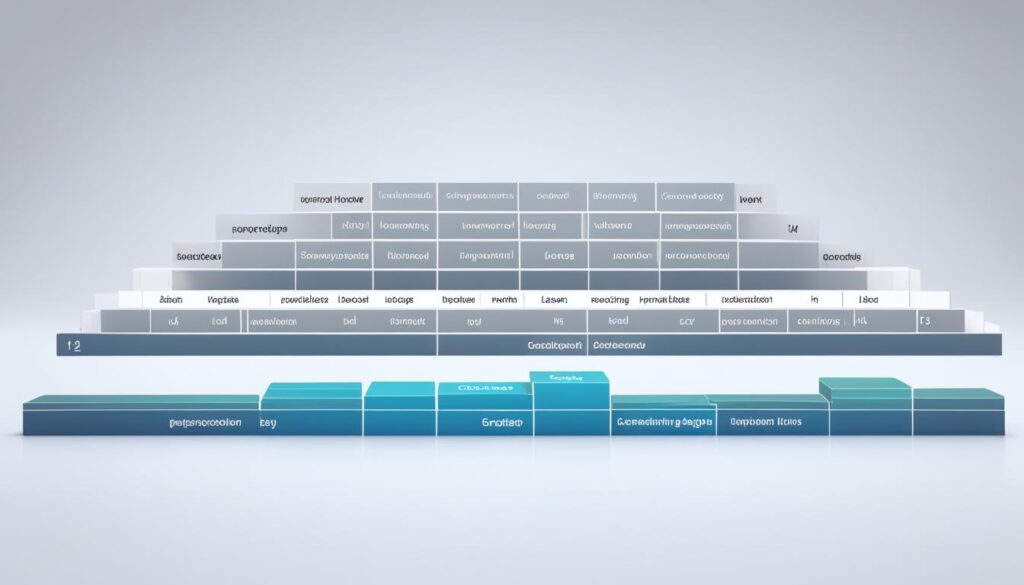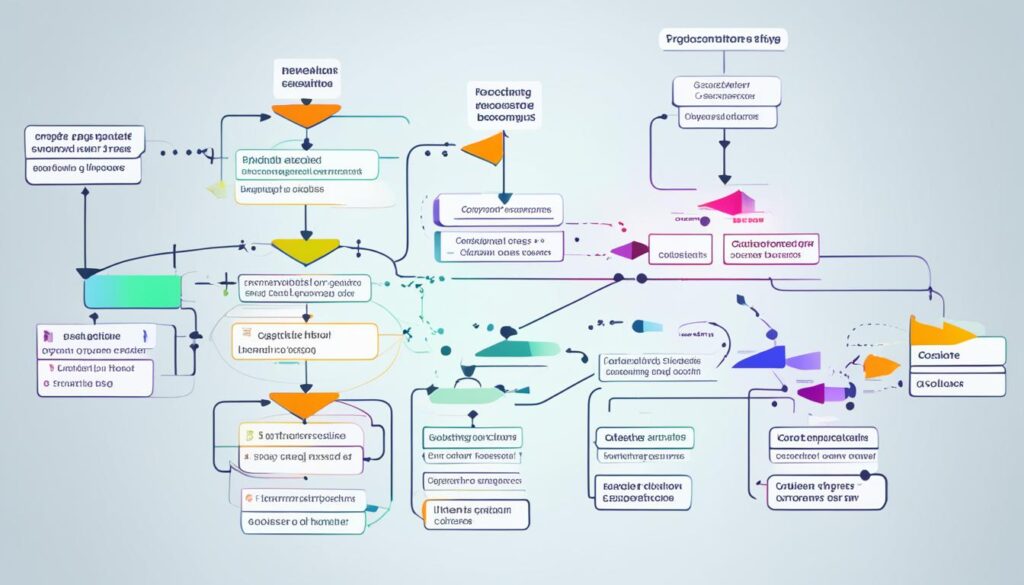Welcome to our article on gradient boosting, one of the most powerful techniques in machine learning. In this guide, we will explore the fundamentals of gradient boosting algorithm, its role in boosting algorithms, and its application in machine learning.
Boosting algorithms, such as gradient boosting, are a type of ensemble learning method that combines multiple weak models to create a robust and accurate model. By sequentially building and correcting the errors made by the previous models, these algorithms significantly enhance predictive performance.
Gradient boosting, in particular, stands out for its remarkable accuracy and its ability to handle large and complex datasets. By minimizing bias errors through a series of iterations, this algorithm achieves superior results.
If you’re new to the concept of boosting in machine learning or want to enhance your understanding of gradient boosting, you’ve come to the right place. Let’s dive in!
Key Takeaways:
- Gradient boosting is a powerful ensemble technique in machine learning.
- It combines predictions from multiple weak learners, usually decision trees.
- Gradient boosting is known for its high accuracy and handling of complex datasets.
- The algorithm works by minimizing bias errors through sequential iterations.
- It is commonly used in regression and classification problems in supervised learning.
Understanding Boosting Algorithms
Boosting algorithms are a type of ensemble learning method that combines multiple weak models to create a strong model. The goal of boosting is to improve overall predictive performance by minimizing the errors made by the individual models.
One popular boosting algorithm is AdaBoost, which starts by building a decision stump and assigns equal weights to all data points. It then increases the weights for misclassified points and decreases the weights for correctly classified points. This iterative process allows AdaBoost to focus on the difficult data points and improve the predictions made by the previous models.
Another widely used boosting algorithm is gradient boosting, which differs from AdaBoost in its approach. Gradient boosting uses a fixed base estimator, usually decision trees, and updates the weights based on the gradient of the loss function. By continuously refining the model based on the errors of the previous iterations, gradient boosting can effectively minimize bias error and improve overall accuracy.
One significant difference between AdaBoost and gradient boosting is that AdaBoost can use different base estimators, while gradient boosting relies on decision trees. This distinction gives gradient boosting the advantage of being able to capitalize on the strengths of decision trees when building the ensemble model.
Boosting algorithms, including AdaBoost and gradient boosting, are powerful tools in the field of machine learning. Their ability to combine weak models and leverage different base estimators, such as decision trees, makes them effective in handling various regression and classification problems.
Boosting algorithms combine weak models to create a stronger ensemble. AdaBoost assigns weights to data points, focusing on misclassified ones, while gradient boosting updates weights based on the gradient of the loss function.
Benefits of Boosting Algorithms
Boosting algorithms offer several advantages in machine learning:
- Improved Predictive Performance: By leveraging the strengths of multiple weak models, boosting algorithms can enhance the overall accuracy and predictive performance of the ensemble model.
- Handles Complex Datasets: Boosting algorithms, such as gradient boosting, are capable of handling large and complex datasets by iteratively refining the model based on errors.
- Reduces Bias Error: The iterative nature of boosting algorithms allows for the gradual reduction of bias errors by correcting the mistakes made by the previous models.
- Addresses Variance Error: By combining multiple weak models, boosting algorithms can reduce variance errors and provide stable predictions.
With their ability to improve accuracy, handle complex datasets, and reduce both bias and variance errors, boosting algorithms play a crucial role in the field of machine learning.
 Boosting algorithms, such as AdaBoost and gradient boosting, are powerful ensemble learning methods that can significantly enhance the accuracy and predictive performance of machine learning models. By combining multiple weak models and leveraging decision trees as base estimators, boosting algorithms provide a robust and effective approach to tackling regression and classification problems.
Boosting algorithms, such as AdaBoost and gradient boosting, are powerful ensemble learning methods that can significantly enhance the accuracy and predictive performance of machine learning models. By combining multiple weak models and leveraging decision trees as base estimators, boosting algorithms provide a robust and effective approach to tackling regression and classification problems.
The Intuition Behind Gradient Boosting
Gradient boosting is a powerful machine learning technique that builds models sequentially in order to correct the errors of the previous model. This ensemble method starts by randomly selecting observations from the training dataset, with each observation initially assigned equal weights.
The first model, known as a weak learner, is built on these weighted data points. If an observation is misclassified, its weight is increased, and if it is correctly classified, its weight is decreased. This process creates a new set of weighted data points for the next model to learn from.
This iterative process continues until the errors are minimized, and the dataset is correctly predicted. Gradient boosting aims to build models that reduce the errors or residuals of the previous models, ultimately leading to a stronger and more accurate final model.
In regression problems, a gradient boosting regressor is used, while in classification problems, a gradient boosting classifier is utilized.

By leveraging the power of weak learners, gradient boosting is able to combine their individual predictions in a way that improves overall model performance. It does so by iteratively adjusting the weights assigned to each observation, allowing subsequent models to focus on the most challenging cases.
The process of building weak learners, modifying weights, and minimizing errors is analogous to climbing down a gradient, hence the name “gradient boosting”. By continuously descending towards the minimum of the loss function, gradient boosting iteratively improves the prediction accuracy.
Throughout each iteration, decision trees are usually employed as the base estimator. Decision trees are capable of handling both regression and classification tasks, making them suitable for a wide range of problems.
Key Takeaways:
- Gradient boosting builds models sequentially to correct errors.
- Weak learners are used in each iteration of gradient boosting.
- Observations that are misclassified are assigned higher weights.
- Observations that are correctly classified are assigned lower weights.
- The goal is to minimize errors and improve prediction accuracy.
- Gradient boosting involves optimizing a loss function.
- Decision trees are commonly used as base estimators.
- Gradient boosting is effective for both regression and classification tasks.
The Mathematics Behind Gradient Boosting
Gradient boosting, a powerful algorithm in machine learning, involves optimizing the loss function by adding weak learners using gradient descent. The algorithm starts by computing the residuals, which are the differences between the actual values and the predictions made by the previous model. These residuals serve as the target variable for the next model, enabling continuous improvement.
By minimizing the loss function, gradient boosting achieves higher accuracy by reducing the discrepancy between predicted and actual values. The loss function represents the difference between the predicted values and the true values in the training set.
To minimize the loss function, the algorithm finds the optimal value of gamma, which represents the predictions made by the previous model. This is achieved by taking the derivative of the loss function with respect to gamma and solving for zero. By adjusting gamma, the algorithm fine-tunes the predictions for better accuracy.
The learning rate, also known as eta, plays a crucial role in gradient boosting. It controls the contribution of each weak learner to the final prediction. With a range between 0 and 1, smaller learning rates reduce the impact of each weak learner, preventing overfitting and improving generalization.
Decision trees are commonly used as base estimators in gradient boosting. These trees are iteratively added, with each tree attempting to correct the errors or residuals of the previous models. By combining the predictions of multiple weak learners, gradient boosting creates a strong model that excels in both regression and classification problems.

The Mathematics Behind Gradient Boosting
Mathematically, the process involves optimizing the loss function by iteratively adding weak learners using gradient descent. The algorithm starts by computing the residuals, i.e., the differences between the actual and predicted values. These residuals are then used as the target variable for the next model. The algorithm finds the optimal value of gamma by taking the derivative of the loss function with respect to gamma and solving for zero. The learning rate, also known as eta, controls the contribution of each weak learner. Decision trees are commonly used as base estimators in gradient boosting.
Comparison of Gradient Boosting and Other Algorithms
| Algorithm | Base Estimators | Optimization Technique |
|---|---|---|
| Gradient Boosting | Decision trees | Gradient descent |
| AdaBoost | Various base estimators | Weighted data points |
| XGBoost | Decision trees | Regularization and pruning |
Conclusion
Gradient boosting is a powerful algorithm in machine learning that combines the predictions of multiple weak learners, usually decision trees, to create a strong model. This boosting technique is known for its accuracy and ability to handle complex datasets, making it an invaluable tool in the field of machine learning.
By continuously optimizing the weights of the model based on the errors of previous iterations, gradient boosting effectively minimizes prediction errors and improves accuracy. It is widely used in both regression and classification problems, showcasing its versatility and applicability in various contexts.
One of the key advantages of gradient boosting is its ability to handle large datasets and minimize bias errors. This makes it particularly valuable when working with complex and diverse data. Additionally, the use of decision trees as base estimators provides flexibility and robustness to the algorithm.
Overall, gradient boosting stands as a fundamental technique within boosting algorithms and ensemble learning. Its capability to combine the strengths of weak learners and iteratively improve upon them makes it a go-to approach for achieving high accuracy in machine learning tasks.
FAQ
What is gradient boosting?
Gradient boosting is a powerful ensemble technique in machine learning that combines the predictions of multiple weak learners, usually decision trees, sequentially.
What are boosting algorithms?
Boosting algorithms are a type of ensemble learning method that combines multiple weak models to create a strong model.
What is the difference between gradient boosting and AdaBoost?
Gradient boosting uses a fixed base estimator, usually decision trees, and updates the weights based on the gradient of the loss function. AdaBoost can use different base estimators and updates the weights based on the misclassification errors.
How does gradient boosting work?
Gradient boosting builds models sequentially, with each model trying to correct the errors of the previous model. It updates the weights of misclassified observations and uses these weights to build the next model.
What is the mathematics behind gradient boosting?
The mathematics behind gradient boosting involves optimizing the loss function by adding weak learners using gradient descent. The algorithm computes the residuals and finds the optimal value of gamma to minimize the loss function.








